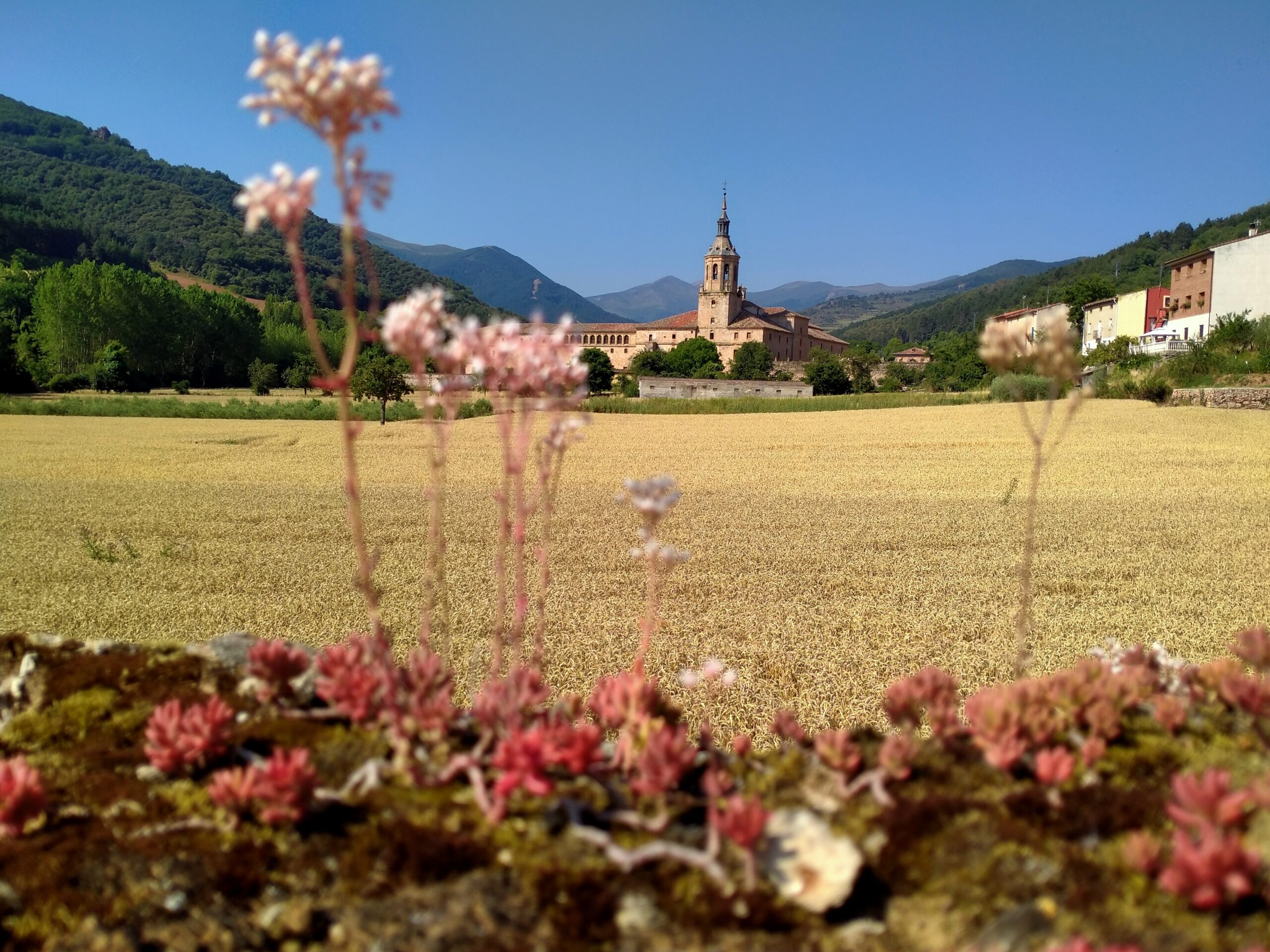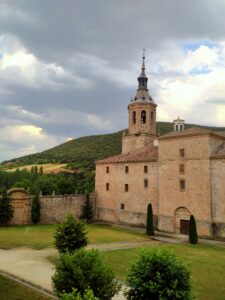
Young voices in heritage is a bimonthly column in our newsletter in collaboration with ESACH (European Students’ Association for Cultural Heritage) featuring young people’s perspectives on cultural heritage.
One, two three, four, five streets flow towards a wall in converging planes, behind which lies assuage to an ochre soiled vision of dry wheat fields and the feeling of approaching to the woods. A wall high and shallow, bearing miniature flowers and succulents on its top overlooking which, one could see a closed window lit up with yellow mercury light inside. Walking alongside the wall, talking to its lichens and mosses you turn your head to see the sacred box and its tower and your eyes stop at the small yellow-lit window which makes you notice that it never goes off. The sacred box which folds and unfolds is the Yuso monastery; a younger sibling of Suso seated in a cultural landscape of La Rioja in San Millan de la Cogolla.
St Millan founded a monastic community in 6th century and it took a form of monasteries, which then became a place of pilgrimage, studded in Romanesque architecture. It is a center of culture, history and religion for the north of Spain which was strongly supported by Royal House of Navarre, the Counts, Kings and Queens of Castile during later centuries mainly because it’s the place where the Spanish language was first written down (WHC Unesco).
 Somebody is always there while many of them are not (the population being very scarce), to greet you ‘Buenos dias’ while you pass by the lovely houses lined up with colourful flowers. Then you hear a car approaching from behind and have to lean sideways on the wall to let it pass, only to realize how narrow the streets are! The wall surrounding the monastery perfectly blends with the people and their houses, so much that they have their day revolving around it. One wide side of it portrays a strong humble support to the sacredness and the people living alongside it, while the other deep end reveals the shortness of its breath due to the flowing ivy and the agony it is going through every day. Although what unifies all of it, is the vernacular essence of it’s built; massing of sandstones bound by lime mortar marching straight and turning corners with columnar pinnacles. At times, it breaks in between, exposing itself to let you peek inside and tell you that it is as humble and strong within too. Then it continues marching towards the river Cardenas and runs parallel to it. Between both lies a road of irony rendering the antithesis of nature. Sky-high wood forest on the left and a crippled old wall bearing the load of a gigantic ivy on the right. Every step to reveal the wall, unfolds a challenge it has overcome or is still going through over the years. Somewhere it burns and cries with the soot, somewhere it opens up wrongfully. Somewhere it cracks open a little bit and somewhere it disappears completely. Sweating off salt crusts of lime, it runs and ends up somewhere green, where the road ends. A survey carried out under European Heritage Volunteering program discovers various degradation patterns observed which are threatening the durability of the wall surrounding the monastery. Material loss, Alveolisation, Biological colonization, Chromatic alteration, are some of many decay taking place.
Somebody is always there while many of them are not (the population being very scarce), to greet you ‘Buenos dias’ while you pass by the lovely houses lined up with colourful flowers. Then you hear a car approaching from behind and have to lean sideways on the wall to let it pass, only to realize how narrow the streets are! The wall surrounding the monastery perfectly blends with the people and their houses, so much that they have their day revolving around it. One wide side of it portrays a strong humble support to the sacredness and the people living alongside it, while the other deep end reveals the shortness of its breath due to the flowing ivy and the agony it is going through every day. Although what unifies all of it, is the vernacular essence of it’s built; massing of sandstones bound by lime mortar marching straight and turning corners with columnar pinnacles. At times, it breaks in between, exposing itself to let you peek inside and tell you that it is as humble and strong within too. Then it continues marching towards the river Cardenas and runs parallel to it. Between both lies a road of irony rendering the antithesis of nature. Sky-high wood forest on the left and a crippled old wall bearing the load of a gigantic ivy on the right. Every step to reveal the wall, unfolds a challenge it has overcome or is still going through over the years. Somewhere it burns and cries with the soot, somewhere it opens up wrongfully. Somewhere it cracks open a little bit and somewhere it disappears completely. Sweating off salt crusts of lime, it runs and ends up somewhere green, where the road ends. A survey carried out under European Heritage Volunteering program discovers various degradation patterns observed which are threatening the durability of the wall surrounding the monastery. Material loss, Alveolisation, Biological colonization, Chromatic alteration, are some of many decay taking place.
‘I am half agony, half love’. Leaving the agony outdoors the monastery lights up the warmth of togetherness and cultural identity, which never goes off. The urge of imparting wisdom is what has kept it alive and throbbing. An articulated sandstone box bearing thousands and thousands of books and archives folds up to the darkest corners of libraries with mercury lamps and monks, while also unfolds in a huge courtyard in the aisles of which goes on painting and calligraphy workshops with Cilengua- a home for International research for Spanish language and cultural heritage. A paradigm of conservation and preservation of its values, bound together with sacredness of the prayer place built in Tuscan order which resembles to that of Borromini. All of this harmony is born and surviving because of the one that sits above, in a cave. The monastery of Suso, the elder one, of Saint Millan beholds the secret of simplicity and gives a piece of peace of mind to anyone and everyone. Being declared Cultural heritage assets by Decree in 1931 and inscribed on World Heritage List in 1997, the two sister monasteries; Yuso and Suso need utmost care by people and for people.
One, two, three, four, five streets flow towards a wall in converging planes, planes of wheat, planes of culture, planes of subtle agony and planes of love.
By Nirmiti Sanjay Sutar, Conservation Architect at ARS Progetti, Rome, Writing and Graphic Editor at ESACH.





Follow us: